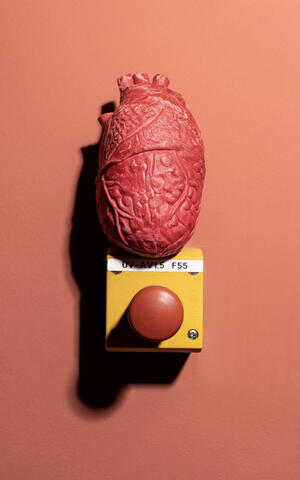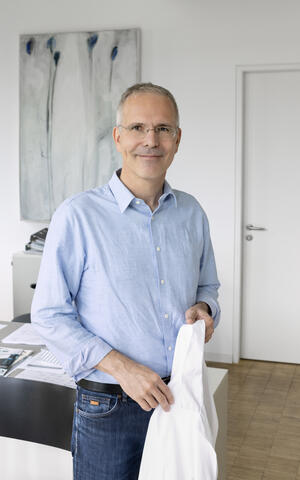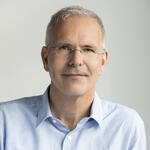The discoverer of hearts
Two things are particularly important to me as a researcher. Staying curious and allowing myself – at least in some cases – to be driven by chance.
In the 25 years he has been at the Max Delbrück Center, Professor Norbert Hübner has found answers to many pressing questions. But exactly what he still wants to achieve in his life as a researcher, he can’t say. “So much in my career has happened quite by chance,” says the 55-year-old scientist. With his gray hair, rimless glasses and simple dark-blue sweater he actually seems like someone who always has a concrete plan under his belt.
“Two things are particularly important to me as a researcher,” says Hübner, “staying curious and allowing myself – at least in some cases – to be driven by chance.” Indeed, Hübner, who heads the Genetics and Genomics of Cardiovascular Diseases Lab at the Max Delbrück Center, didn’t originally want to go into research at all. When he started studying medicine in Heidelberg in 1989, shorty after the fall of the Berlin Wall, the Bremen-born student wanted to become a doctor.
But chance dictated otherwise: During the first semester he encountered the pharmacologist Detlev Ganten, who later became the founding director of the Max Delbrück Center. Ganten not only sparked his enthusiasm for research but also showed him how inspiring it can be to gather together people with the same interests who stimulate and complement each other’s scientific curiosity.
“Right at the beginning of my studies I organized a seminar together with other students, supported by Detlev Ganten. Every time we addressed a different medical topic,” Hübner explains. “We invited the most high-ranking experts we could to share their current state of knowledge and discuss the burning issues in their field.”
Understanding the heart cell by cell
Hübner’s pleasure in networking has not waned. For what is for him probably the most impotant project, the Atlas of the Human Heart, he has drummed up scientists from all over the world. Researchers from the UK, the United States, Canada, China and Japan – including his old friends Jonathan and Christine Seidman from Harvard Medical School in Boston, where Hübner once spent two years as a doctoral candidate – want to understand the human heart cell by cell.
For their first draft of the Human Heart Cell Atlas, which they presented in “Nature” in 2020, the team analyzed the RNA of some half a million individual cells and cell nuclei from six regions of the human heart. “In this way we can discover which genes in the cells are active and what type of cells they are,” Hübner explains. He coordinates the large-scale project together with Jonathan Seidman. “We have discovered an incredible diversity of cells and molecules: unknown subtypes of heart muscle cells and supporting heart cells, protective immune cells in the heart and an extensive network of blood vessel cells.”
Nonetheless, this work is still in its infancy, he notes. Since 2021, for example, Hübner has been working with almost the same team on an atlas of the juvenile heart. “We have aready analyzed the first eight organs at single-cell level,” reports the researcher. But in the future, he also wants to map the adult heart in much more detail. “To explain when, how and why a healthy heart turns into a diseased heart we first have to understand the healthy organ as well as possible,” says Hübner.
Of course, he hopes that at some stage his research will benefit people with heart conditions. “Cardiovascular diseases are still the most frequent cause of death worldwide,” says Hübner. Every year, more than 20 million people are newly diagnosed with heart failure; about 20 percent of them die within a year.
Fascinated by medical puzzles
Two types of heart failure, in particular, have sparked his interest: hypertrophic cardiomyopathy (HCM), which involves the thickening of the heart chambers, and dilated cardiomyopathy (DCM), whereby especially the left ventricle is over-expanded. In both cases, the heart’s ability to pump is reduced. In 2022, together with colleagues, for instance, Hübner was able to demonstrate in the journal “Science” that DCM is not a homogeneous disease. Rather, mutations in the genes for three important proteins in the heart that occur in clusters have quite different consequences. “This builds on the Heart Atlas. Without that knowledge this study would not have been possible,” says Hübner.
Another puzzling form of heart failure that he is just trying to understand in the context of a DFG (Deutsche Forschungsgemeinschaft) collaborative research center has the complicated title, “Heart Failure with preserved Ejection Fraction”, known for short as HFpEF. “It’s mostly women who suffer from HFpEF; my own mother has it,” Hübner reports. “In people like this, the heart’s pumping capacity seems to be completely normal – but they still get absolutely exhausted when they climb stairs.”
Solving puzzles like this in medicine motivates Hübner day in, day out. The question as to how he relaxes after a tiring day in the lab or at his desk almost annoys him a bit. “My work is my hobby,” he says, “I don’t really need to recover from it.” And science is simply not a nine-to-five job, he notes. However, he does try to go jogging every day – preferably with his wife who has her office just round the corner: Professor Young-Ae Lee heads the Molecular Genetics of Chronic Inflammation and Allergic Disease Lab at the Max Delbrück Center and also works one day a week as a pediatric immunologist at Charité – Universitätsmedizin Berlin.
The two of them met when they were studying in Heidelberg. “Of course, it’s immensely fortunate that both of us have our own research groups at the Max Delbrück Center,” says Hübner. It had always been important to them to realise their careers together and a cause of great happiness that it had worked out for them both.
Researching for patients
The researcher looks back particularly fondly on their time together in Singapore where she spent a six-month sabbatical. “The period at Duke National University was really the icing on the cake of my career up to then,” says Hübner. “No administration, take a deep breath and concentrate exclusively on science – it was brilliant.”
In Stuart Cook’s lab he intensively investigated the neurotransmitter Interleukin 11 (IL-11) which is largely responsible for the heart producing too much connective tissue during HCM, DCM or a heart attack and thus stiffening. “We are now able to prevent a fibrosis like this in animal models with antibodies against IL-11,” says Hübner proudly. “The first clinical trials will start soon.” He can only recommend his colleagues to go on sabbatical.
But Hübner also gets really rapturous when he talks about his everyday work as a research group leader. “I keep getting inquisitive, highly-motivated young people joining my team who all have the same goal: to discover something new,” he says. They all bring along a kind of creativity you only find in few other professions.”
With the best in his field
Unlike art, science only works in teams.
Gathering creative minds around him is something the scientist has always loved. From 2007 to 2012, for instance, he organized the annual Cold Spring Harbor Conference on Long Island in New York. “After a big consortium of us had decoded the rat genome in 2004, we had developed several rat models to help understand human heart conditions and other diseases better,” explains Hübner. These models were a major topic at the conferences which even attracted Nobel laureates like Svante Pääbo.
“Working together with the best in the field, sharing ideas with one another – all that is very stimulating and generates immense strength,” says Hübner. He doesn’t see himself as fighting a lonely battle, but as part of a coherent whole, a small cog in a large machine that will finally benefit humanity. “Unlike art, science only works in teams,” he says. That was something the French physiologist Claude Bernard recognized back in the 19th century. At the time, he said: art is I, science is we. For Norbert Hübner that’s a good motto. After all, explorers are seldom on the road alone.
Text: Anke Brodmerkel








